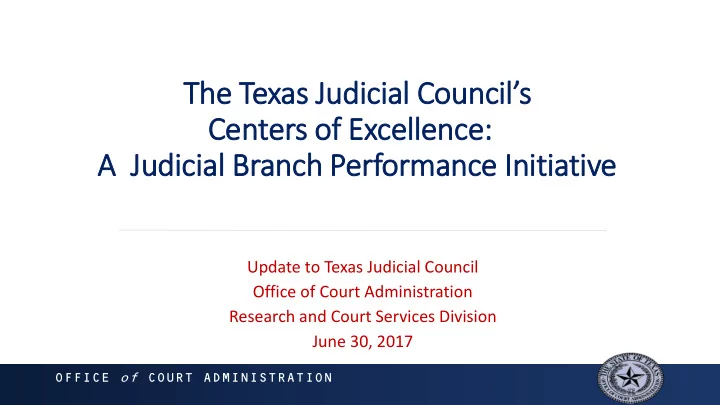

The Texas Judicial Council’s Centers of Excellence: A A Ju Judicial Branch Performance In Initiative Update to Texas Judicial Council Office of Court Administration Research and Court Services Division June 30, 2017 OFFICE of COURT ADMINISTRATION
Court Performance Initiative - Is Is designed to assist courts and court systems in assessing and improving their performance - Is Is based on recognized approaches to studying and improving court performance - Is Is supportive of local innovation and priorities - Is Is not a “one -size-fits- all” approach to court management
Pilot Jurisdictions Court Systems El Paso County, District and County Courts Hays County, District Courts Courts Webb County, 49 th District Court Webb County, 406 th District Court Webb County, County Court at Law No.2 Seguin Municipal Court
Program Overview – Phase 1 PHASE 1 Complete Readiness Assessment Consult with OCA Select jurisdiction representative
Readiness Self-Assessment Compelling Need There is a compelling need, pressing reason or opportunity in your court to undertake a performance improvement project. Stability and Commitment Key actors (judges, administrators, managers, others) have time over the next 12-18 months to participate in developing and following through on a project to improve court performance. Interest in Improvement Key actors (judges, administrators, managers, others) have an interest in undertaking a performance improvement project and making its pursuit a priority.
Readiness Self-Assessment Willingness to Assess Key actors (judges, administrators, managers, other) are willing to critically assess the court's performance and open to considering the results. Willingness to Change Key actors (judges, administrators, managers, other) are open to setting performance standards and changing the way they do their work to align with performance-related goals. Open to Resource Reallocation Key decision makers are open to reallocate resources, if necessary, to support and sustain the court's performance improvement project.
Readiness Self-Assessment – Pilot Site Example Respondents either AGREE or STRONGLY AGREE … Compelling Need 100% Stability and Commitment 20% 80% 20% 80% Interest in Performance Improvement 20% 80% Willingness to Assess Performance 20% 80% Willingness to Change Practices Open to Reallocate Resources 40% 60%
Program Overview – Phase 2 PHASE 2 Complete Performance Inventory Receive Performance Profile from OCA Create Performance Plan
Proposed Performance Areas Strategic Professional Thinking and Development Planning Business Access to Caseflow Governance Processes Justice Management Technology Procedural Data Driven Resources Fairness Management Access Data Driven Governance Court Operations and Caseflow Fairness Management
Performance Areas Data-Driven Governance Caseflow Management Access & Court Fairness Operations
Performance Areas Governance The court’s structure and authority for policy decision -making and implementation is effective and the court is committed to transparency and accountability. Court Operations The court effectively performs, manages and monitors its operations and services. Data-Driven Caseflow Management The court uses data to ensure that work is performed efficiently and to promote the fair and timely resolution of all cases. Access & Fairness The court is accessible to all and court procedures are fair and understandable.
Performance Areas Data-Driven Caseflow Management Governance Access & Court Fairness Operations
Data-Driven Performance Inventory Caseflow Management ❶ Does your court have a written case management plan? ❷ Does your court have a written continuance policy? ❸ Does your court monitor the reasons for continuances in each case? ❹ Does your court monitor the time from filing to disposition against a performance standard?
Data-Driven Performance Inventory Caseflow Management ❺ Does your court monitor the number of appearances from filing to disposition for criminal cases? ❻ Does your court monitor complex cases to ensure a timely resolution? ❼ Does your court monitor the number of cases heard on the first scheduled trial date? ❽ Does your court produce real-time reports and information that are used by court staff and judges in managing cases?
Performance Profile – Pilot Site Example PERFORMANCE AREA’S STRENGTH INDEX Governance 67% Data Driven Caseflow Management 44% Access & Fairness 88% Court Operations 75%
Performance Inventory – Pilot Site Not Being Done Being Done • Does your court have a written case • Does your court have a written management plan? NO continuance policy? YES • Does your court monitor the reasons for continuances in each case? NO • Does your court monitor complex cases to ensure a timely resolution? YES • Does your court monitor the time from filing to disposition against a • performance standard? NO Does your court produce real-time reports and information that are used by court • Does your court monitor the number of staff and judges in managing cases? YES appearances from filing to disposition for criminal cases? NO • Does your court provide court personnel • Does your court monitor the number of and judicial officers with opportunities for cases heard on the first scheduled trial training in case management practices, date? NO court performance monitoring, analysis and management? YES
Performance Plan – Pilot Site • Draft and implement a written case management plan • Develop and implement systems to monitor the reasons for continuances • Develop and implement systems to monitor the time from filing to disposition against a performance standard • Develop and implement systems to monitor the number of appearances from filing to disposition for criminal cases • Develop and implement systems to monitor the number of cases heard on the first scheduled trial date
Program Overview – Phases 3 and 4 PHASE 3 Implement Performance Plan Participate in Excellence Assessment conducted by OCA PHASE 4 Jurisdiction is recognized by the Judicial Council as a Judicial Center of Excellence
Next Steps… • Distribute and discuss each pilot jurisdiction's Performance Profile with them • Jurisdictions will develop and begin to implement a performance improvement plan with assistance and resources from OCA as needed • Jurisdictions will participate in an Excellence Assessment conducted by OCA • Jurisdictions may be recognized by the Council as a Judicial Center of Excellence • Planned opening of the program to all interested jurisdictions: October 2017
Recommend
More recommend